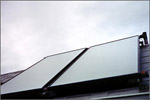Generating Heat Actively with Solar Energy
Active solar heating systems combine the mechanical components of a regular heating system with a passive solar system. Heat is collected with a solar collector, but fans or pumps are used to circulate the heated fluid. There is usually some type of storage system as well.
1. Solar Thermal Collector: Just like passive solar systems, heating water with an active system requires a flat plate collector to absorb the sun's energy. Mounted on the roof, the flat tank contains a black surface to maximize heat absorption. Tubes attached to the surface circulate water. As the black surface collects heat, it gets trapped in the tank and raises the temperature of the circulating water.


2. Primary Circuit: The solar collector and external part of the tank comprise the primary circuit.
3. Water Storage Tank: Just like an electric or gas-driven hot water system, an insulated tank is used to store hot water until needed.
4. Pump: Rather than relying solely on gravity, active systems use pumps to circulate the water. Cold water is pumped into the collector where it heats up. Then it's pumped to the storage tank. Hot water is pumped from the tank throughout the house.
5. Water Heater: Some systems use a backup water heater. The heater can supply extra hot water to the storage tank if needed.
3. Water Storage Tank: Just like an electric or gas-driven hot water system, an insulated tank is used to store hot water until needed.
4. Pump: Rather than relying solely on gravity, active systems use pumps to circulate the water. Cold water is pumped into the collector where it heats up. Then it's pumped to the storage tank. Hot water is pumped from the tank throughout the house.
5. Water Heater: Some systems use a backup water heater. The heater can supply extra hot water to the storage tank if needed.

